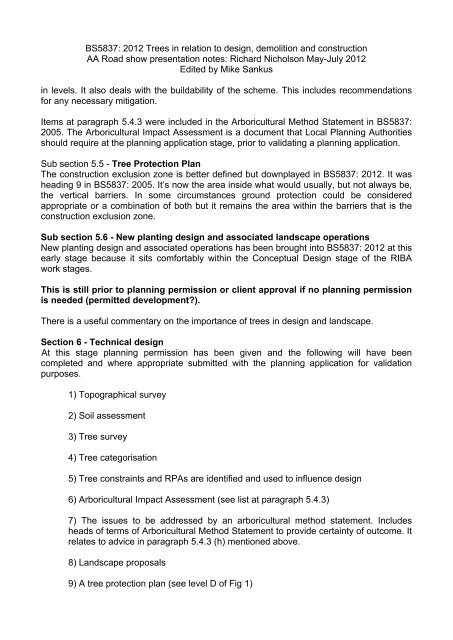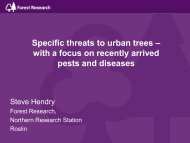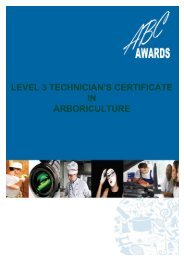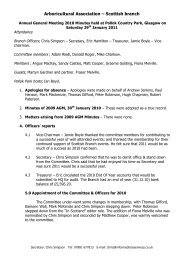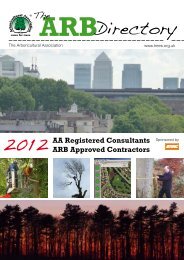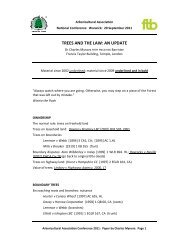BS5837: 2012 Trees in relation to design, demolition - Arboricultural ...
BS5837: 2012 Trees in relation to design, demolition - Arboricultural ...
BS5837: 2012 Trees in relation to design, demolition - Arboricultural ...
You also want an ePaper? Increase the reach of your titles
YUMPU automatically turns print PDFs into web optimized ePapers that Google loves.
<strong>BS5837</strong>: <strong>2012</strong> <strong>Trees</strong> <strong>in</strong> <strong>relation</strong> <strong>to</strong> <strong>design</strong>, <strong>demolition</strong> and construction<br />
AA Road show presentation notes: Richard Nicholson May-July <strong>2012</strong><br />
Edited by Mike Sankus<br />
<strong>in</strong> levels. It also deals with the buildability of the scheme. This <strong>in</strong>cludes recommendations<br />
for any necessary mitigation.<br />
Items at paragraph 5.4.3 were <strong>in</strong>cluded <strong>in</strong> the <strong>Arboricultural</strong> Method Statement <strong>in</strong> <strong>BS5837</strong>:<br />
2005. The <strong>Arboricultural</strong> Impact Assessment is a document that Local Plann<strong>in</strong>g Authorities<br />
should require at the plann<strong>in</strong>g application stage, prior <strong>to</strong> validat<strong>in</strong>g a plann<strong>in</strong>g application.<br />
Sub section 5.5 - Tree Protection Plan<br />
The construction exclusion zone is better def<strong>in</strong>ed but downplayed <strong>in</strong> <strong>BS5837</strong>: <strong>2012</strong>. It was<br />
head<strong>in</strong>g 9 <strong>in</strong> <strong>BS5837</strong>: 2005. It’s now the area <strong>in</strong>side what would usually, but not always be,<br />
the vertical barriers. In some circumstances ground protection could be considered<br />
appropriate or a comb<strong>in</strong>ation of both but it rema<strong>in</strong>s the area with<strong>in</strong> the barriers that is the<br />
construction exclusion zone.<br />
Sub section 5.6 - New plant<strong>in</strong>g <strong>design</strong> and associated landscape operations<br />
New plant<strong>in</strong>g <strong>design</strong> and associated operations has been brought <strong>in</strong><strong>to</strong> <strong>BS5837</strong>: <strong>2012</strong> at this<br />
early stage because it sits comfortably with<strong>in</strong> the Conceptual Design stage of the RIBA<br />
work stages.<br />
This is still prior <strong>to</strong> plann<strong>in</strong>g permission or client approval if no plann<strong>in</strong>g permission<br />
is needed (permitted development?).<br />
There is a useful commentary on the importance of trees <strong>in</strong> <strong>design</strong> and landscape.<br />
Section 6 - Technical <strong>design</strong><br />
At this stage plann<strong>in</strong>g permission has been given and the follow<strong>in</strong>g will have been<br />
completed and where appropriate submitted with the plann<strong>in</strong>g application for validation<br />
purposes.<br />
1) Topographical survey<br />
2) Soil assessment<br />
3) Tree survey<br />
4) Tree categorisation<br />
5) Tree constra<strong>in</strong>ts and RPAs are identified and used <strong>to</strong> <strong>in</strong>fluence <strong>design</strong><br />
6) <strong>Arboricultural</strong> Impact Assessment (see list at paragraph 5.4.3)<br />
7) The issues <strong>to</strong> be addressed by an arboricultural method statement. Includes<br />
heads of terms of <strong>Arboricultural</strong> Method Statement <strong>to</strong> provide certa<strong>in</strong>ty of outcome. It<br />
relates <strong>to</strong> advice <strong>in</strong> paragraph 5.4.3 (h) mentioned above.<br />
8) Landscape proposals<br />
9) A tree protection plan (see level D of Fig 1)


